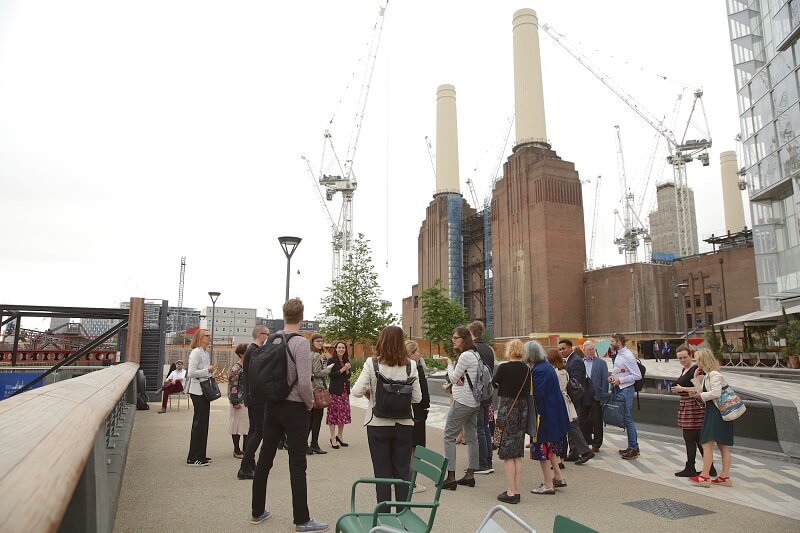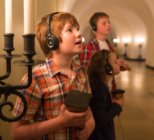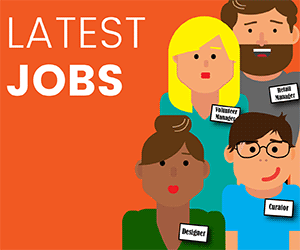Reveal
Reveal is the brainchild of Collusion, a not-for-profit company set up by Simon Poulter and Rachel Drury in 2014 that creates ‘ambitious, disruptive, immersive, and interactive public artworks and events that consider the impact of emerging technology on society’.
Operating around the Cambridge area, the team’s latest project was ‘Reveal’, a ‘part game, part narrative, part adventure’ that ran between 23rd November 2018 and 4th January 2019 in Kings Lynn. The immersive ‘active reality’ story told the story of a Syrian refugee set against the backdrop of the streets and avenues of the Norfolk seaport town, and the narrative unfolded day by day, using large-scale projections, augmented reality, film sequences and live performances.
You may like: Pixels, bricks and mortar: Can Digital Placemaking Save the High Street?
Collusion set up a ‘shop’ on the high street where people could stop by to find out about the project and how they could get involved. Participants were invited to actively explore the town, looking for the black and white ‘R’, which they could then scan with their smartphones to crack the code and discover a new piece of the story.
As part of the project, Collusion also worked closely with schools and community groups, engaging over 300 children in coding and technological activities such as making digital light boxes.
Reveal demonstrates perfectly how digital placemaking can inspire and engage a community to connect differently with the streets around them, and with each other. By telling an oft-unheard story, the project merged the historic with the contemporary for a uniquely compelling experience.
Every Thing Every Time
Poetry is probably the last thing that comes to mind when you think about data, but Naho Matsuda’s Every Thing Every Time connects the two to powerful effect.
Commissioned by Great Exhibition of the North, Matsuda’s installation consists of a custom-built split flap display board bearing poetry, outside Newcastle’s Theatre Royal. The words displayed are not ‘written’ by a person, rather randomly created by data gathered from the daily lives of the city’s inhabitants. As the installation interacts with data collated from sensors at the city’s Urban Observatory and other buildings in the city centre, the data is transformed into words, creating ‘impractical poetry’.
In addition to the installation, Matsuda also created a podcast which takes a closer look at the stories from the city. Listeners are invited to delve deeper into the city and hear individual stories of some of its inhabitants.
Matsuda’s work manages to achieve the seemingly impossible: it transforms data on things like traffic, weather and travel into meaningful words full of humanity and beauty. In this way, Every Thing Every Time serves to create a further, tangible connection between the people and their city.
Starling Crossing
One of the ways that digital placemaking has helped cities develop and thrive is through safety initiatives. Digital technology doesn’t just serve to connect and engage people to spaces, it also serves a practical purpose, as demonstrated by Umbrellium’s Starling Crossing.
Starling – or STigmergic Adaptive Responsive LearnING Crossing – has been developed to meet the needs of 21st century road use. Starling uses familiar road crossing colours and patterns, but where it differs is that it’s a responsive, real-time system designed to prioritise pedestrian safety.
Using computer-controlled LEDS (which are embedded into the road surface), cameras track objects moving on the road surface. Apart from being able to distinguish between pedestrians and vehicles, the technology also calculates velocities, trajectories and precise locations, in order to accurately judge where they’ll be in the next moment.
The digital crossings and markings appear according to real-time need. Apart from the crossing points, if someone is distracted and gets too close to vehicles, nearby cars and cyclists will see a warning pattern light up around them. Similarly, if a child runs into a road, a buffer zone illuminates around them to highlight their presence to oncoming traffic.
Starling highlights how digital technology can transform busy urban environments into more welcoming, safer spaces for everyone. Led by truly innovative thinking, the project is a great example of groundbreaking vision. Through the use of multiple technologies, Starling manages to put pedestrians at the centre of urban mobility systems.
Museum Experimental Guide: National Museum of Singapore
Created as part of their ‘Digimuse’ series, the Museum Experimental Guide for the National Museum of Singapore is a showcase in transformative museum design.
Visitors that download the app can use it to trigger a wide range of location-specific experiences – including AR visualisations of artefacts and historical events, and AI-powered content, delivered by a digital host, MEG (Museum Experimental Guide).
The effect, as explained by Digimagic director Donald Lim, is a mixed reality museum experience that engages visitors through gamification and dynamic content. What’s striking is not the existence of the app itself – most major museums now offer smartphone-enabled content – but the maturity of the project. MEG makes use of multiple digital technologies and adopts a blank-canvas approach that will allow new museum exhibits to be added to the platform.
Battersea Power Station, Circus West Village
The first phase of the Battersea Power Station redevelopment was Circus West Village, and to complement it, Calvium were commissioned to plan, design and execute a digital placemaking experience.

Few buildings are as iconic to Londoners as Battersea Power Station. For many decades, from both sides of the Thames, the Art Deco structure has cast an imposing silhouette, reminding us that it lies empty – until recently. In 2012, plans were announced to redevelop the disused station into a town centre complete with shops, green spaces, restaurants, offices and homes.
Calvium’s brief was to link past with present by telling the story of the history of the building, how it shaped London and how the space has evolved. The resulting Heritage Trail app connects visitors to the historic space via GPS, artificial reality and rich location-based storytelling.
Apart from the heritage trail and a game for younger participants, the jewel in the crown of the project was an immersive AR feature: allowing visitors to open a virtual doorway and experience the grandeur of the hitherto unseen Art Deco control rooms of the Power Station itself.
Vandal’s Three Little Pigs
In case you hadn’t heard, 2019 is the year of the Pig, symbolising fortune and good luck. To mark this auspicious Chinese New Year, World Square commissioned Vandal to help Sydney celebrate in style.
The campaign centred around the idea of the three little pigs with three jolly pig statues erected in Sydney’s World Square.
However, the posing pigs were much more than just lifeless sculptures. Visitors were invited to use augmented reality to bring the pigs to life and even dance alongside them on a giant screen. In addition to the lively dance-along, participants could also play the Lucky Pig Game by collecting and scanning lucky red packets for the chance to win prizes and offers.
Unsurprisingly people loved the three little pigs – the campaign went viral, generating more than 10 million views. Apart from highlighting a significant cultural event, this type of campaign demonstrates the power of digital placemaking to spark real joy by bringing people together to have fun and discover something together in real-time.
Camden People’s Museum
Camden People’s Museum is an exciting project that challenges the notion of what a museum is and seeks to create a digital space that brings to life the stories of its diverse inhabitants. Although it’s a museum, it will have no walls, no entry fees and will essentially be curated by the people for the people.
Set in specific locations around the borough of Camden, the immersive exhibition will be brought to life through augmented reality as well as live performances.
Jon Meggitt, CEO and Co-founder of Arcade, is leading the project and believes that it will help people truly connect with the place they call home, ‘Arcade is all about building connections between people and places using augmented reality, so the opportunity to immerse residents and visitors alike in the rich stories and unique environments of this iconic borough is a vision that’s very close to our hearts.’
This project highlights the need for, and impact of, re-connecting people with the spaces they inhabit. Living somewhere doesn’t necessarily mean you feel part of a community or connected to the place, but it should. Projects like Camden People’s Museum are changing the way people feel about their environments and also about themselves.
Amsterdam Light Festival
Each year, Amsterdam Light Festival bathes the city – a placemaking hotspot – in luminescent artwork, transforming the streets into a dazzling gallery space.
While many of the artworks are static – like Alicia Eggert’s All the Light You See – others use digital technology to respond to residents and deepen their viewing experience.
In last year’s edition, Sjimmie Veenhuis’ Action>Reaction 2.0 encouraged visitors to follow their curiosity and interact with his artworks’ shifting colourscape by pressing buttons and creating new patterns. In the same year, Felipe Prado’s playful Picto Sender Machine asked viewers to use their bodies to record and share a message using coloured light. Femke Schaap’s Virtual Fairground riffed on the fractious relationship between the city’s residents and visitors to create an immersive, kaleidoscopic light playground that both groups would enjoy – subversive digital placemaking at its most playful.
Digital placemaking comes in many forms and is used for many reasons but there is a common theme in all the examples we’ve looked at: people. At its heart, placemaking is about reminding us that the spaces we inhabit or visit are not simply functional; they inform and enhance the human experience, connecting us to the spaces around us and each other.
We’ve been practising (and preaching) around Digital Placemaking for many years. To find out more check out some of our other projects, or read our deep dive on the what, how and why of Digital Placemaking.
We’ve been practising (and preaching) around Digital Placemaking for many years. To find out more check out some of our other projects, or read our deep dive on the what, how and why of Digital Placemaking.











